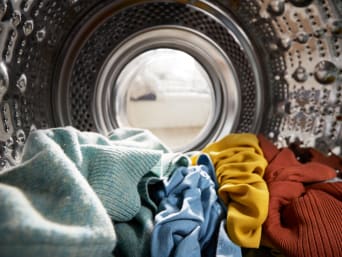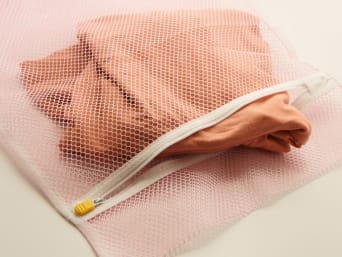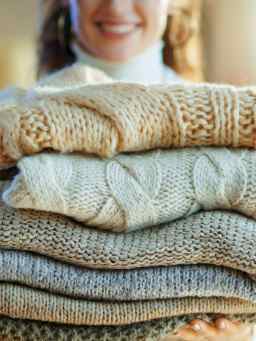The essential guide on washing delicates
Fabrics must endure washing, spinning and drying before they become clean. Each fabric requires special care to avoid any discolouration or shrinkage. Special care needs to be taken with delicate materials such as cashmere, leather, mohair or velvet. These types of materials need to be washed and cared for differently compared to hard-wearing materials so that they do not get damaged. In the following article we will show you how you can clean and care for delicate materials so that they last longer.
What are delicates?
A standard wash program is not suitable for delicate materials. Washing at a high temperature, using the wrong laundry detergent and washing at high spin speeds can damage, shrink or cause discolouration. Therefore, it is recommended to wash delicates on an easy care or delicate wash program.
The term delicates is used to describe clothes and home textiles made out of very sensitive fibres that need to be gently washed. The wash programs are usually referred to as delicates or handwash.
Below you will find a list of delicate materials:
Silk
Clothes with prints, sequins and embroidery.
Satin, chiffon and lace are also delicate materials.
Practical clothes such as sportswear or outdoor clothing and various synthetic materials such as viscose often need to also be washed on a delicates wash program. These types of materials are often referred to as "easy care laundry".
General tips on washing delicates
Delicates needs to be washed separately to help maintain their quality. Regardless of the material, there are a few general care tips for delicate materials that you should always follow.
1. Always check the care label
In order to find out how an item of clothing should be washed it’s recommended to have a look at the care label. This is particularly important for delicate materials because the different washing and care symbols indicate whether a particular item of clothing can be washed at home or if it should be dry cleaned.
2. How to separate your clothes
Delicates should never be washed with hard-wearing materials because they are usually washed at high temperatures and with a laundry detergent, which is not suitable for delicate materials. Therefore, it is important to separate your washing. Firstly, sort your clothes into two piles one for delicates and one for everyday washing. Secondly, check the recommended temperature it should be washed at and then sort the clothes into two new piles. The final step is to sort by colour such as whites, colours and darks.
Tip: Some items of clothing are made out of various materials. If your clothes are made out of mixed fabrics and if any of them are delicate materials, then you should wash them accordingly to avoid damaging the fabric. However, if you are unsure you should contact a dry cleaner.
3. Using a laundry net bag
A lot of delicate materials should not only be washed separately, but they also need special protection. This is the case with items of clothing such as: lingerie or lace lingerie. It is recommended to use a laundry net bag or a pillowcase to help protect the delicate material whilst in the washing machine.
4. Keeping zips and buttons fastened
Make sure to fasten any buttons and zips on clothes before putting them into the washing machine as they can easily get tangled and pull threads, especially on delicate materials. This also helps to ensure that clothes become less creased after having been in the washing machine.
5. Selecting the correct wash program
Double check the washing instructions on the care label to make sure you select the correct wash program:
A number in a wash bowl: this indicates the maximum temperature something can be washed at. A maximum temperature of 30°C is usually recommended for delicates. Synthetic materials can often be washed at 40°C.
A washing bowl with a line underneath it: this means that the clothes should be put on a gentle cycle. Use a wash program for delicates or an easy care wash program.
A washing bowl with two lines underneath it: this symbols means that wash programs such as handwash or a delicates wash program should be used. If your washing machine has a special wash cycle, such as a wool wash, you can also use this.
A washing bowl with a hand in it: this symbol means that you should clean it carefully in the sink or in a washing up bowl. This is also a possible alternative if your washing machine does not have a suitable handwash or delicates wash program.
A crossed out washing bowl: clothes with this symbol mean that they cannot be handwashed or washed at home, instead they need to be dry cleaned.
6. Using the correct laundry detergent
When it comes to washing delicates it is very important to make sure that you use the correct laundry detergent. Make sure to only use laundry detergents that are specially for delicates. These types of laundry detergents do not contain bleaching agents or optical brighteners and use milder surfactants to protect the fibres. For delicate materials such as wool there are also special laundry detergents. Avoid using fabric softener in order to protect the delicate fibres, as this can cause the fibres to stick together and thus reduce the breathability of the materials.
Useful washing tips for delicates
In addition to the general care tips for delicate materials, there are also a lot of instructions on how to wash and care for specific materials. By following the wash instructions, you can get the most out of your clothes.
How to wash wool
A well-known delicate material is wool. You should always follow a few tips when it comes to washing wool so that your woollen jumper stays softer for longer and it doesn’t become misshapen.
If there is a washing symbol with a bowl of water that is underlined once or twice, then the item of clothing can be washed in the washing machine on a special wool wash program with a suitable laundry detergent. If the washing machine does not have a special wool wash program, then you can wash wool on a handwash program. A mild shampoo can also be used as a substitute for laundry detergent to clean the fibres in wool. After woollen clothes have been in the washing machine it is advisable to pull them back into shape and to dry them lying down so that they do not become misshapen.
Further detailed information and helpful tips on how to clean wool can be found here:
How to wash cashmere
Cashmere is one of the most precious materials among wool products and requires even more care than wool. Therefore it is advised to use the wool wash program for cashmere clothes or they can be carefully handwashed. Cashmere should not be washed at temperatures above 30°C and should be rinsed several times with cold water after washing it. As with wool it is better to dry cashmere clothes on a flat surface. To do this, pull the garment back into shape and lay it on a towel. This also applies to washing and caring for clothes made out of mohair and angora.
In our cashmere guide you can find out more about washing and caring for cashmere:
How to wash silk
Silk is well known for being soft and shiny and it should always be washed at a low temperature with a special laundry detergent for delicates. Conventional laundry detergents can attack the fibres, which as a result will make the material feel rough and brittle. If you would like to wash silk clothes in the washing machine, you should also wash them on a delicates wash program. In addition, silk clothes should never be wrung or put on a spin cycle.
How to wash velvet
Velvet is becoming increasingly popular in the fashion industry. However, it is a delicate material that should not be tumble dried, folded or ironed. If any velvet clothes have stubborn stains it is highly recommended to get them dry cleaned.
Tip: Clothes made out of crushed velvet or a mix of velvet and polyester can usually be washed in the washing machine on a cold water wash with a mild laundry detergent. These materials are more hard-wearing and can withstand a gentle wash program.
How to wash leather
Leather usually does not need to be washed thanks to the material being a little bit waterproof and most stains and dirt can be easily wiped off.
You should not wash genuine leather in the washing machine. The seams on clothes made out of leather can become misshapen in the washing machine and regular laundry detergents and washing at high temperatures can attack the protective layer on the material. If you would like to have anything made out of leather cleaned you will need to take it to a dry cleaners.
In general, faux leather can be washed in the washing machine, but make sure to double check the care label before washing it. Turn your faux leather clothes inside out and place them in a laundry net bag if necessary. Wash faux leather on a gentle wash program with a low spin speed and set the temperature as low as possible such as a cold wash or a maximum temperature of 30°C.
How to wash sportswear and outdoor clothing
Modern materials and textiles include softshell and membrane fabrics, which can be found in various outdoor clothes and sportswear. It is important to use the correct laundry detergent when washing and caring for these types of materials. There are special laundry detergents that do not make the fibres become tangled and do not impair the properties of the materials. For some types of clothes such as raincoats, there are special laundry detergents available that make the textiles waterproof again. However, you should avoid using fabric softener on these types of materials as it can stick to the delicate fibres and damage their structure. These types of clothes may seem hard-wearing, but they should be washed at a maximum of 40°C on a handwash program or a gentle cycle. It is advised to leave outdoor clothing and sportswear to air dry, but do not expose them to direct sunlight.
What is the difference between easy care and delicates?
Delicates need to be washed on a special wash program. The term "easy care" is somewhat misleading as it does not refer to materials that are hard-wearing. Easy care laundry needs to be gently washed to help stop creasing or the items of clothes becoming misshapen. This is also important for clothes which have special material properties such as sportswear or outdoor clothing.
Delicates and easy care laundry need to be washed in different ways:
Temperature: it is recommended to wash delicates at a maximum temperature of 30°C. Cold washing is also often recommended. Easy care laundry can often be washed at 30 to 40°C.
Spin speed: the spin speed is even lower for delicates, for example, maximum 600 to 800 revolutions. On an easy care wash program a slightly higher spin speed can be set as needed, for example, 800 to 1200 revolutions.
Machine load: the recommended amount for a washing machine drum load for an easy care wash program is usually about half, but for delicates you should only fill the washing machine drum to about a quarter.
When should delicates be dry cleaned?
The dry cleaners will clean delicates without the use of water. This prevents the sensitive fibres from swelling and losing their shape. If there is a symbol on the care label with a crossed out washing bowl with the letters "P" and "F" this means that item of clothing needs to be dry cleaned.
Suits, evening or wedding dresses and woollen coats are usually cleaned at the dry cleaners. You should also take any items of clothing made out of delicate materials such as silk, wool, chiffon and tulle to the dry cleaners. Leather should ideally be dry cleaned if certain stains and odours cannot be aired out, brushed or carefully wiped off.
Conclusion – how to wash delicates
Clothes made out of cotton can be washed at home as they are quite heat resistant. However, make sure to check the care label on clothes made out of silk, cashmere, wool or velvet. If the care label shows that they can be machine washed, you can clean them gently with a mild laundry detergent and on a delicates wash program. You can also protect particularly delicate fibres with a laundry net bag. If you are unsure about how to wash any particular items of clothing or if you cannot wash them in the washing machine, then we would recommend contacting a professional dry cleaner.
______________________________________________
The image sources in this text are in chronological order
Cover photo: iStock.com/monkeybusinessimages
1 Image in text: iStock.com/Vasyl Dolmatov
2. Image in text: iStock.com/bungoume
3. Image in text: iStock.com/NYS444
4. Image in text: iStock.com/Oleh_photographer















